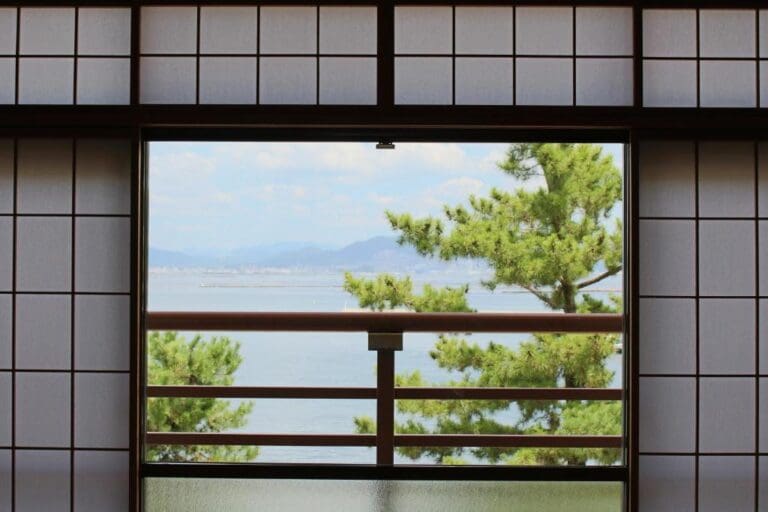The best part of Miyajima happens after most people leave. When the last ferry sails back to the mainland, the island gets quiet. The shops close. The selfie sticks vanish. You can stand in front of the shrine and actually hear the water move. Staying overnight matters—and staying in the right ryokan makes the difference between a nice memory and something you’ll keep thinking about long after the trip ends. This article compares traditional ryokan in Miyajima, sorted by budget range.
Quick Comparison Table
| Ryokan | Location | Starting Price (for two adults) | Unique Features | Booking Link |
| Ryoso Kawaguchi | Quiet side street | ~¥15,000 | Family-run, home-style kaiseki, private bath slots | Booking.com |
| Yamaichi Bekkan | Near ferry terminal | ~¥30,000 | Only 4 rooms, exceptional food, halal & vegan meals | Booking.com |
| Miyajima Seaside Hotel | Waterfront, north coast | ~¥34,000 | Ocean views, public baths, free shuttle | Booking.com |
| Jukeiso | Hillside near shrine | ~¥36,000 | Panoramic torii views, rooftop dining, private bath | Booking.com |
| Iwaso | Inside Momijidani Park | ~¥70,000 | Historic, onsen, forest setting, refined kaiseki | Booking.com |
| Kurayado Iroha | Main shopping street | ~¥60,000 | Boutique design, rooftop onsen with torii view | Booking.com |
Ryoso Kawaguchi (Affordable)
- Best for: Travelers who want a quiet, low-key stay with genuinely good food and warm, hands-on hospitality.
- Price range adults: ¥15,000-¥30,000
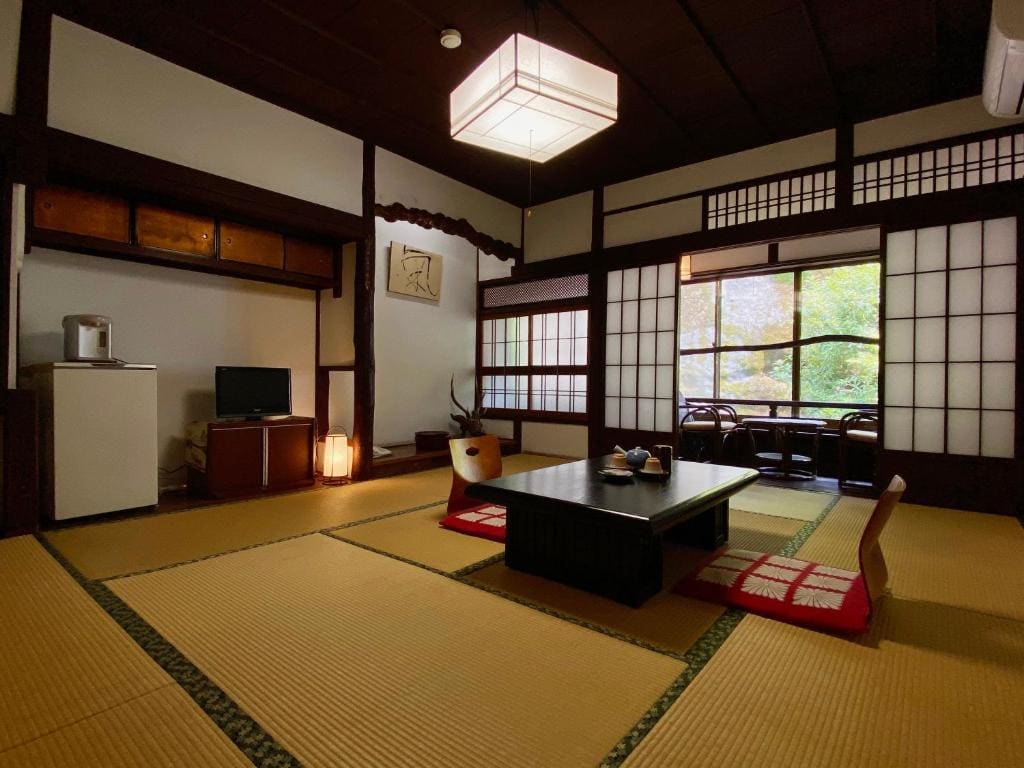
Ryoso Kawaguchi is one of those places that doesn’t try to impress but ends up doing exactly that. It’s located just a few minutes’ walk from Itsukushima Shrine, but tucked off the main road, on a quiet residential side street. From the outside, it doesn’t look like much. But once you’re inside, it feels calm, organized, and surprisingly personal.
The ryokan is run by a couple who do everything themselves. There are only a handful of rooms, all in traditional Japanese style with tatami floors and futons. They’re clean, quiet, and basic in a good way. If you want to bathe, there’s a small private-use bath you can book at check-in. It’s not an onsen, but it’s well-kept and ideal if you’re traveling as a couple or want to avoid public baths.
What really stands out here is the food. Dinner is home-cooked kaiseki—not restaurant-style perfection, but meals that feel like they were made just for you. Several travelers have said this was the best meal of their entire trip to Japan. The menu changes with the seasons, but it usually includes sashimi, grilled fish, local vegetables, and a few dishes that are unique to the region. Breakfast is also excellent and just as carefully prepared.
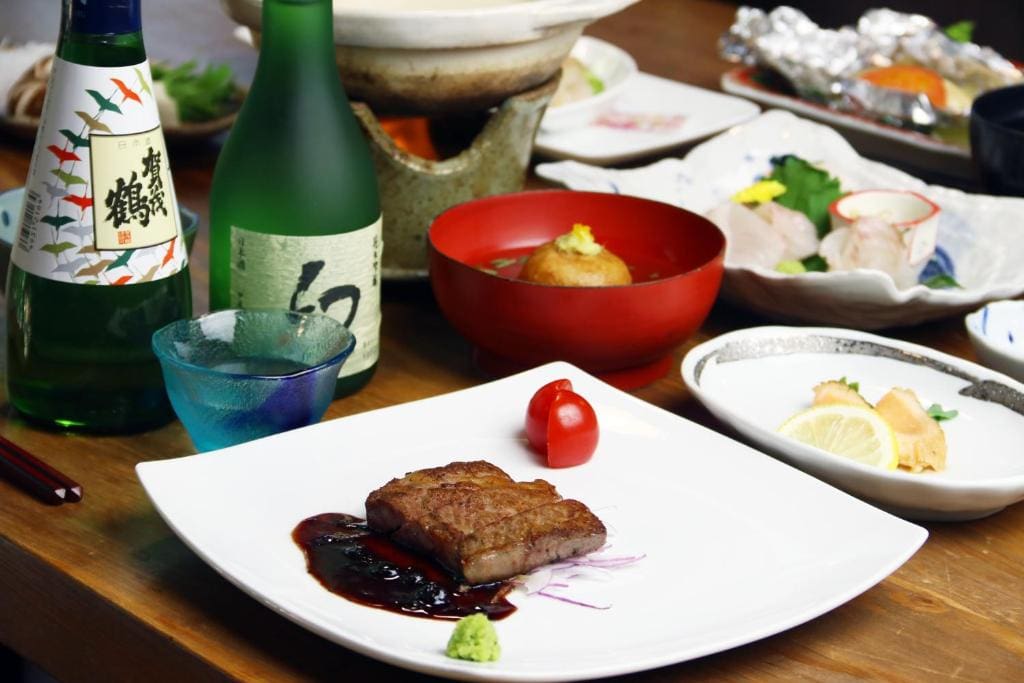
The hosts don’t speak much English, but they know how to communicate. They’re used to foreign guests and are incredibly kind. Expect little touches: welcome tea when you arrive, explanations written out in English, help with your ferry schedule, and quiet attention throughout your stay.
There’s nothing flashy about this place, but it delivers exactly what a ryokan should—calm, care, and food that stays with you long after the trip is over.
Yamaichi Bekkan (Affordable)
- Best for: Couples or solo travelers who want a friendly, home-style stay with excellent food and no fuss. Also a great option if you need halal or plant-based meals.
- Price for two adults: ¥30,000
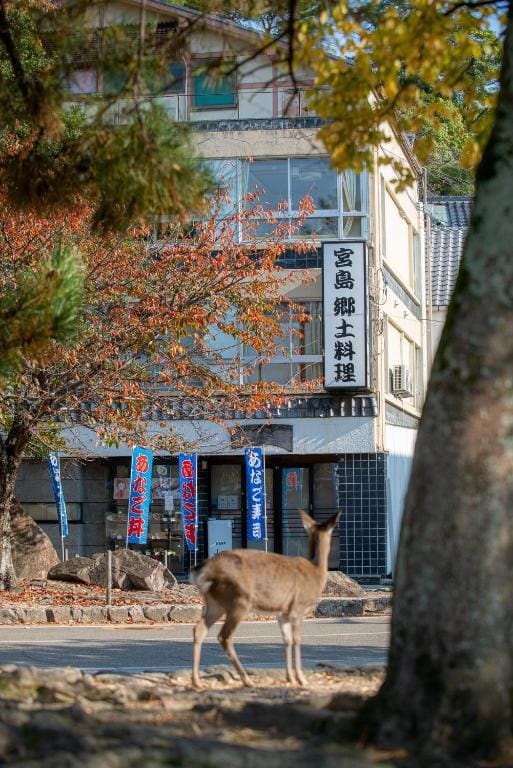
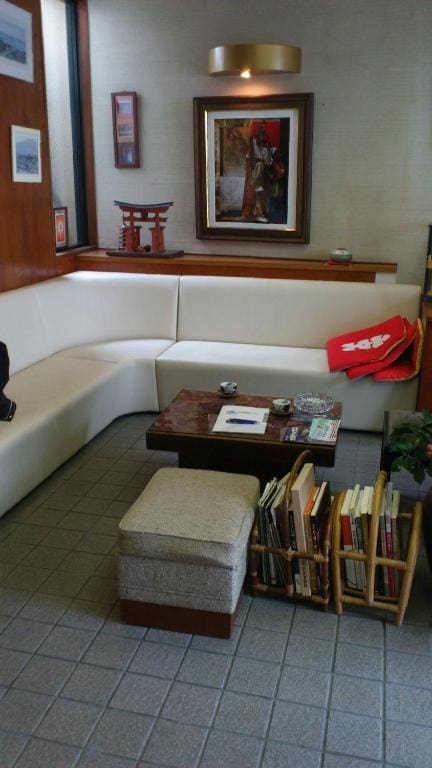
Yamaichi Bekkan is the kind of place people remember for its warmth. The ryokan has only four rooms that can accommodate up to two guests each, and it sits directly across from the Miyajima ferry terminal. That might sound like a touristy spot, but it’s surprisingly quiet once you’re inside. The whole place is run by one family. They check you in, cook your meals, serve your breakfast, and chat with you if you’re curious about the island.
Rooms are simple and clean. One is Western-style with beds, the others have tatami mats and futons. There’s no elevator, so you’ll need to take the stairs, but the building isn’t tall. Each room has a private bathroom. There’s no onsen, and no big shared baths—it’s not that kind of place. But if you’re coming for one night, it’s more than enough.
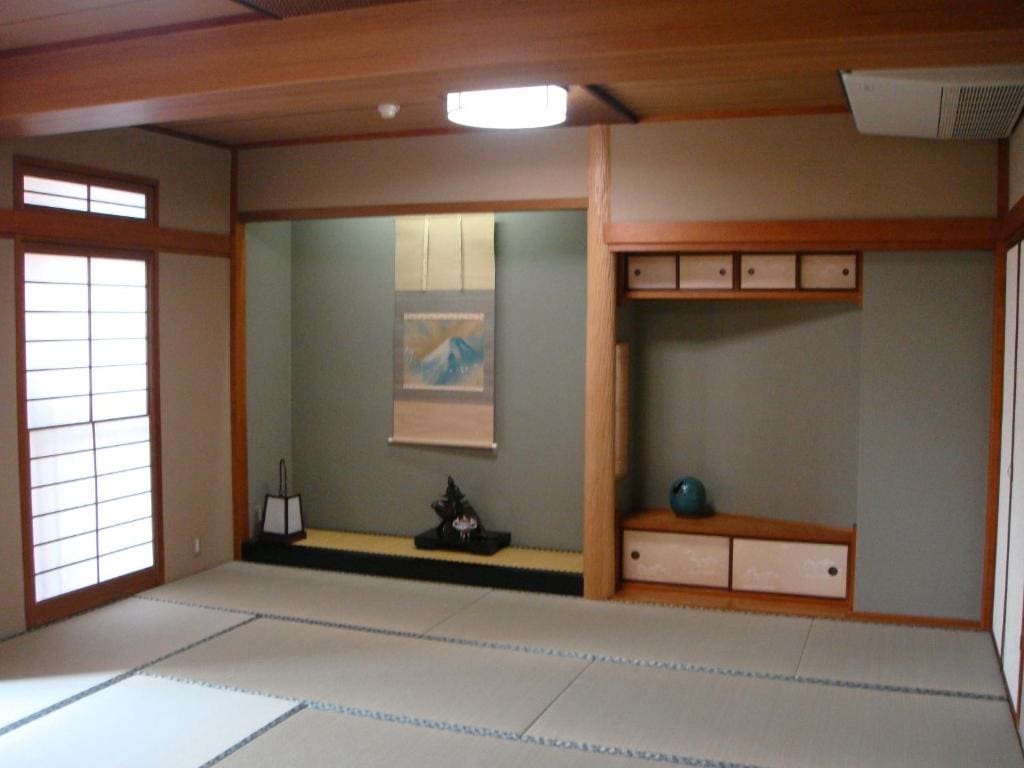
What makes this ryokan special is the food. Dinner is served in the small restaurant on the ground floor, and it’s genuinely good. Seasonal fish, anago (sea eel), fresh vegetables, homemade sauces—the kind of meal you’d expect in a much more expensive place. If you need a vegan or halal option, they’ll make it for you. They’re one of the few places in Japan that can do both well, and they take those requests seriously.
Breakfast is simpler but still thoughtful. Grilled fish, miso soup, pickles, rice, tea. Enough to keep you full until lunch. If you have dietary needs, they’ll adjust here too.
Service is informal and kind. The owners speak some English and are used to international guests. They’ll help with luggage, give sightseeing tips, or adjust meal times if your ferry arrives late. Nothing feels scripted or corporate—it’s more like staying with a local family who happens to run a ryokan.
Miyajima Seaside Hotel (Mid-range)
- Best for: Families or small groups who want extra space, ocean views, and an easygoing atmosphere away from the crowds.
- Price range for two adults: ¥34,000-¥46,000
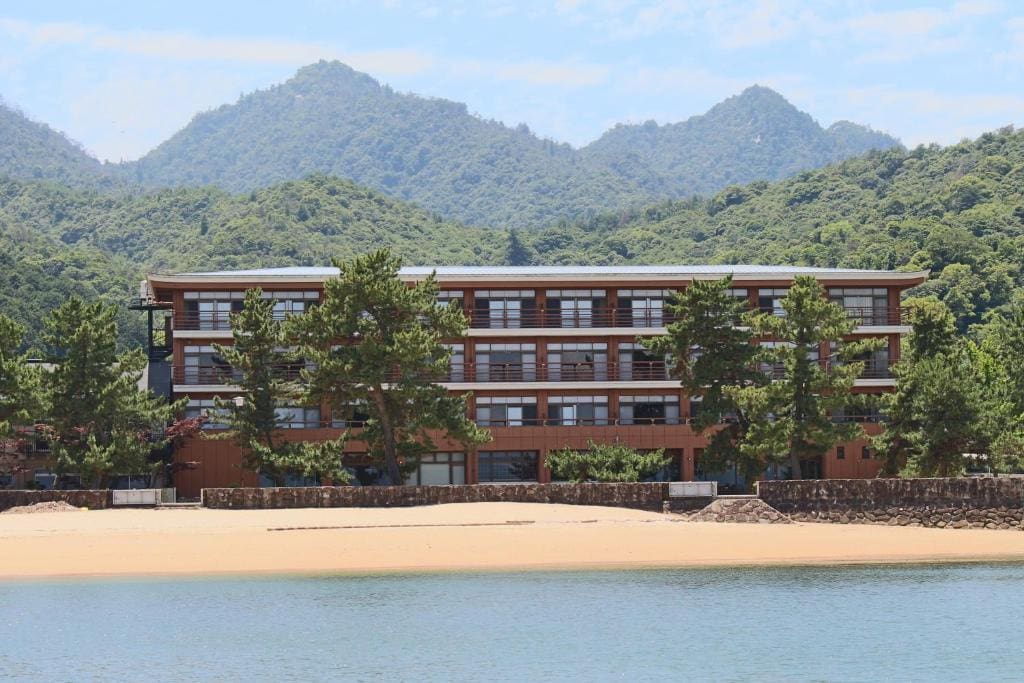
Miyajima Seaside Hotel sits on the quieter northern coast of the island, a short shuttle ride from the ferry terminal. It’s a bit removed from the main shopping streets and tourist spots, but that’s part of the appeal. The area is peaceful, the shoreline is just steps away, and the sea views are wide open and unobstructed. If you’re looking for calm and space, this part of the island delivers it.
The hotel is larger than most ryokan, with 45 rooms in total. Most are Japanese-style with tatami floors and futons, though a few have Western beds. The rooms are spacious, especially compared to what you’ll find in central Japan. Many face the sea, and the view is especially nice at sunset or early morning. While the building itself is a little dated, everything is well maintained, clean, and functional.
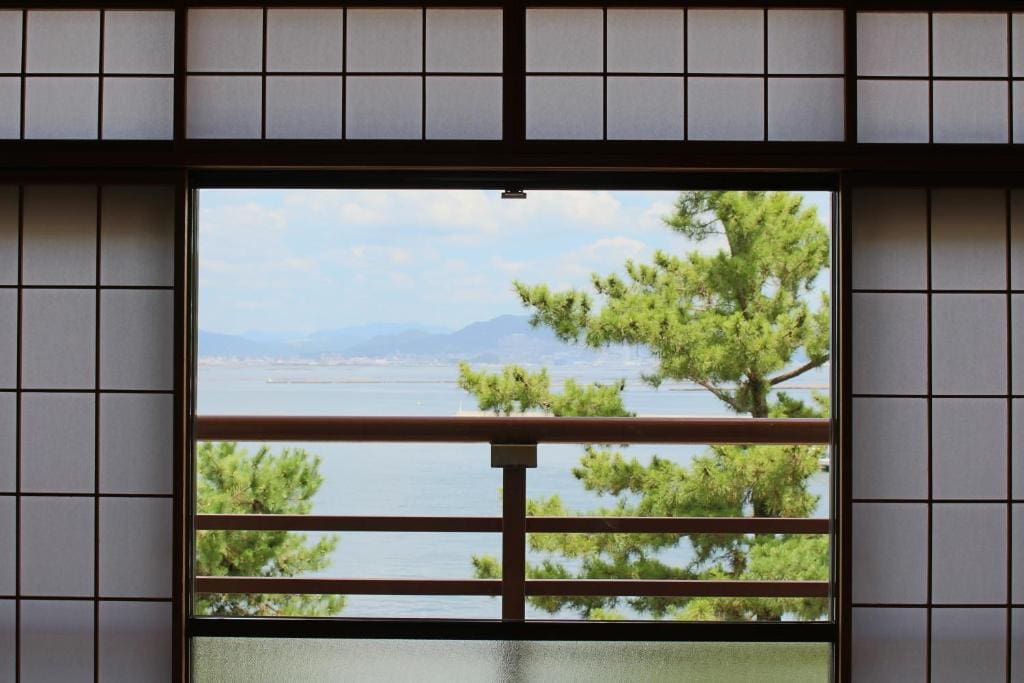
There’s a large public bath inside, and a smaller open-air tub that looks out over the water. The baths aren’t fed by a natural hot spring, but they’re pleasant and relaxing, especially after dinner. If you go later in the evening, it’s usually quiet.
Meals are served in the dining room, with a focus on local specialties. In colder months, they often serve oyster hot pot, grilled fish, or sashimi from the Seto Inland Sea. The presentation is simple but the ingredients are fresh and well prepared. Breakfast is traditional Japanese, with miso soup, rice, grilled fish, and seasonal sides. If you have dietary preferences, it’s best to contact them in advance.
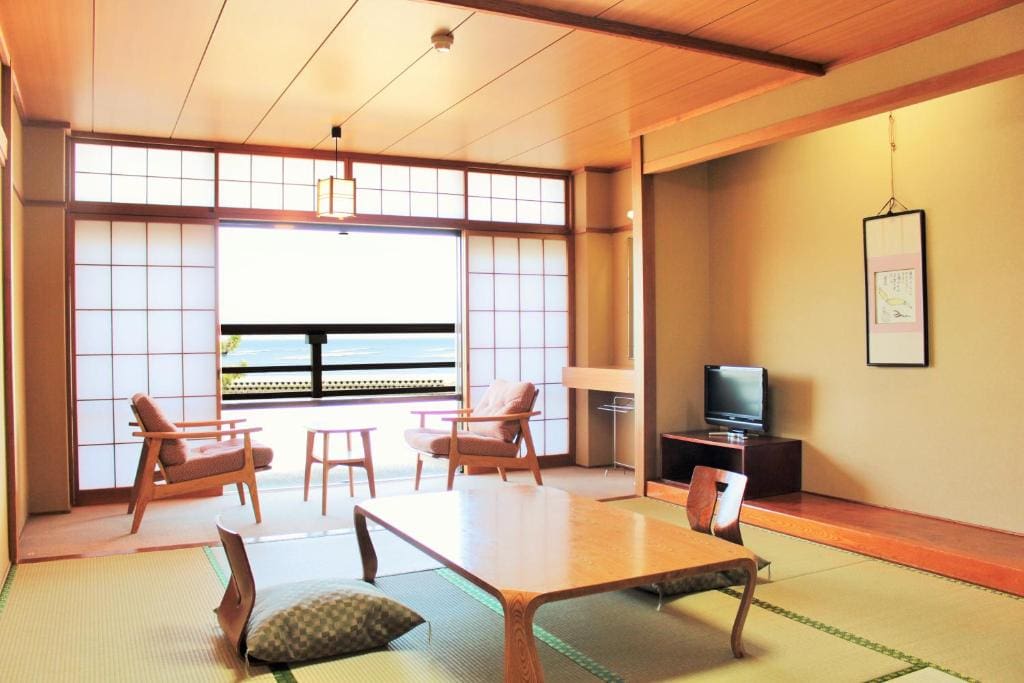
Service is thoughtful and professional. The staff are used to international guests and communicate well. The shuttle service to and from the ferry is fast and easy to arrange, and they’ll gladly store your luggage before or after your stay.
This isn’t a luxury ryokan, and it doesn’t try to be. What you get is space, a quiet location by the sea, and a dependable ryokan-style experience at a reasonable price.
Jukeiso (Mid-range)
- Best for: Couples who want to stay somewhere calm, scenic, and close to the island’s most famous landmarks.
- Price range for two adults: ¥36,000-¥66,000
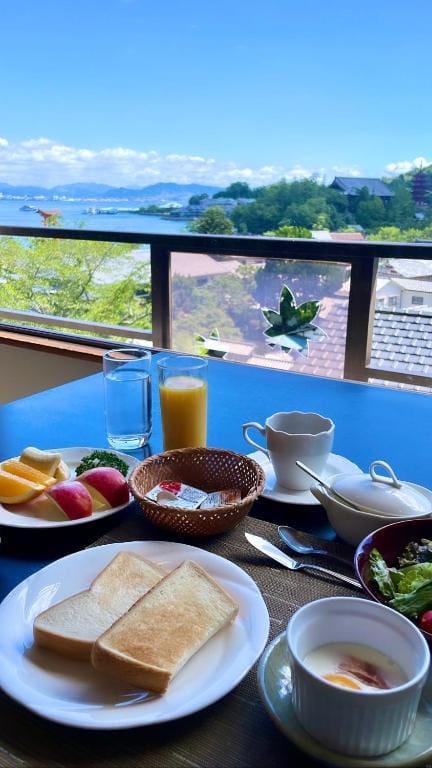
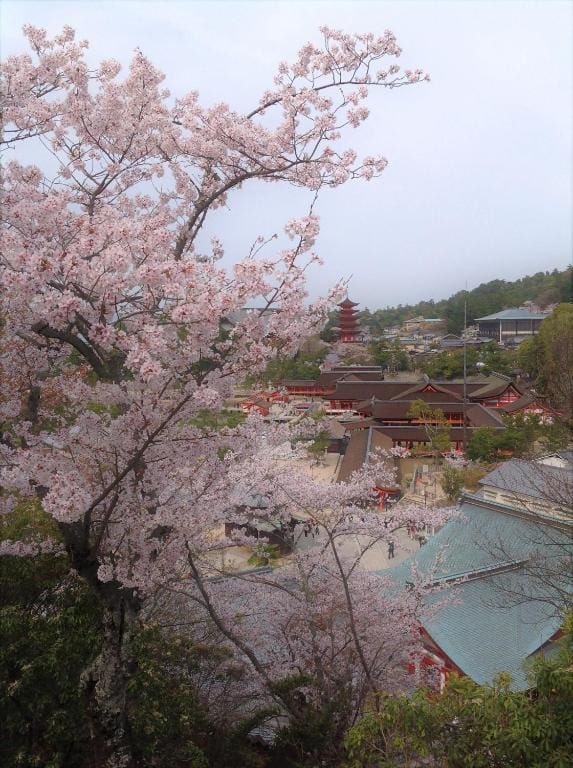
Jukeiso is best known for its view. The ryokan is perched on a hillside above Itsukushima Shrine, and from many of the rooms, the rooftop lounge, or the dining area, you can see the famous torii gate framed by the sea. If you’re staying only one night and want to wake up or eat dinner looking out over Miyajima’s most iconic sight, this is one of the best places to do it.
It takes about five to ten minutes to walk uphill from the main area of the island to reach the property, but the staff can pick you up at the ferry terminal starting from 3 PM. The walk is manageable even with light luggage, but the shuttle is convenient if you’re arriving with bags.
The rooms are traditional, with tatami floors and futons. Each room has its own private bathroom, which isn’t always the case at this price point. Some rooms have a more modern feel than others, but all are clean and quiet. The building itself is modest, and the style is fairly classic, with wooden details and large windows that let in the light.
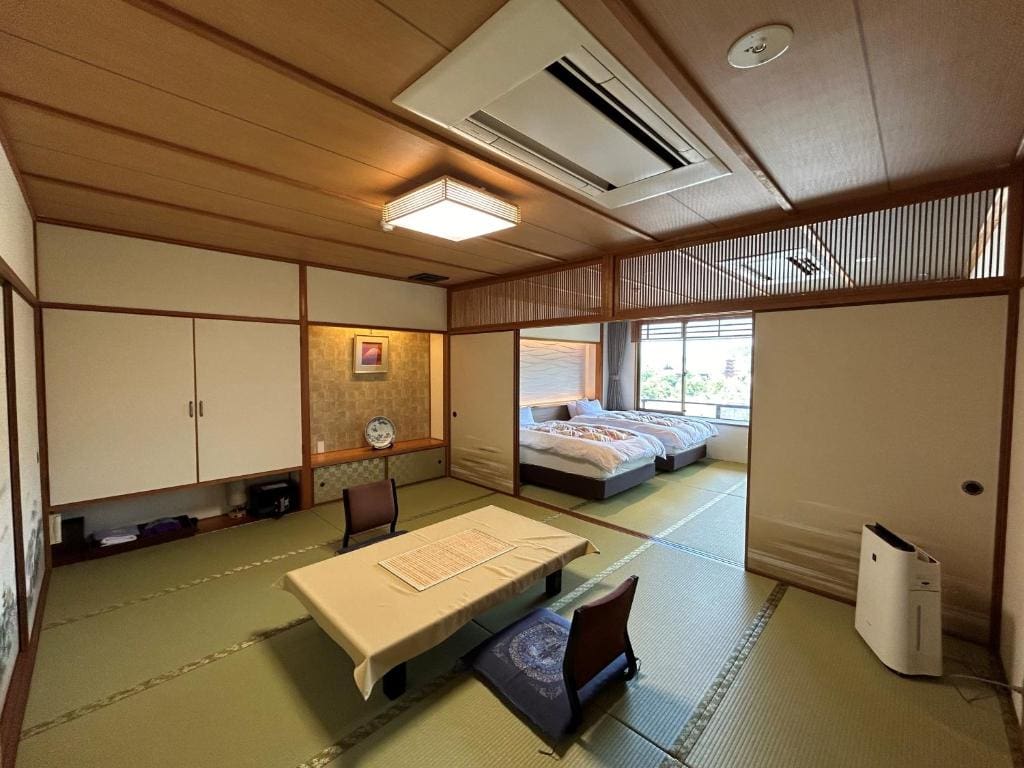
Dinner is served in a common dining room at the top of the building, with large windows that make the most of the view. The kaiseki-style meal includes seasonal seafood, local produce, and a few regional touches. Most guests find the food fresh and satisfying, even if it isn’t especially elaborate. Breakfast is Japanese-style and served in the same space, with similar care and attention to detail.
There’s a small communal bath on site, open 24 hours, and a private bath that you can reserve when you check in. It’s not an onsen, but it offers a quiet way to unwind at the end of the day.
Jukeiso isn’t flashy. It’s a comfortable, mid-sized ryokan that delivers a rare view in a peaceful setting. The highlight here is less about what’s in the room and more about what’s outside your window.
Iwaso (Luxury)
- Best for: Travelers who want a classic ryokan stay in a natural setting, with a focus on atmosphere, tradition, and quiet. Ideal for a honeymoon or a one-night splurge.
- Price range for two adults: ¥70,000-¥100,000

Iwaso is the most iconic ryokan on Miyajima, and also the oldest. It was founded in 1854, and it shows, in a good way. The buildings are set inside Momijidani Park, a quiet wooded valley just a few minutes from the shrine. A small stream runs through the grounds. In the early morning, you might see deer walking past your room. At night, the path is lit by soft lanterns. It’s peaceful, timeless, and the opposite of what you get in a modern hotel.
There are three types of rooms: the historic wooden main building, a newer modern wing, and a few standalone cottages. All are traditional in style, with tatami floors, low tables, and sliding doors. Some rooms have private bathrooms, others don’t—it depends on the category. Most guests stay in the main building or the newer wing, where everything is clean, quiet, and well-kept, even if the style leans more classic than luxurious.
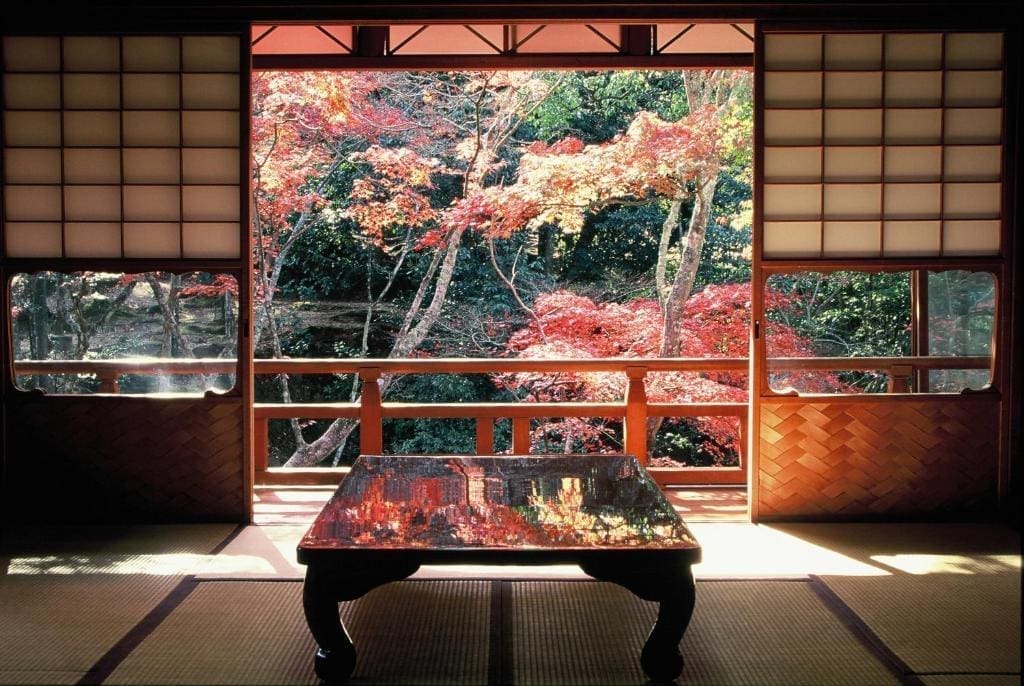
Meals are served in your room by a staff member in kimono, which is part of the appeal for many guests. Dinner is a full kaiseki course with seasonal ingredients—expect oysters in winter, local vegetables, maybe a small nabe hotpot, and sashimi. Breakfast is also traditional and includes miso soup, grilled fish, rice, and several small dishes that change daily. Portions are generous, but not overwhelming.
Iwaso also has its own onsen. There’s a large indoor bath and a smaller open-air tub surrounded by trees. It’s not the biggest bath on the island, but the setting—especially at night—is hard to beat. If you go after dinner, you’ll probably have it to yourself.
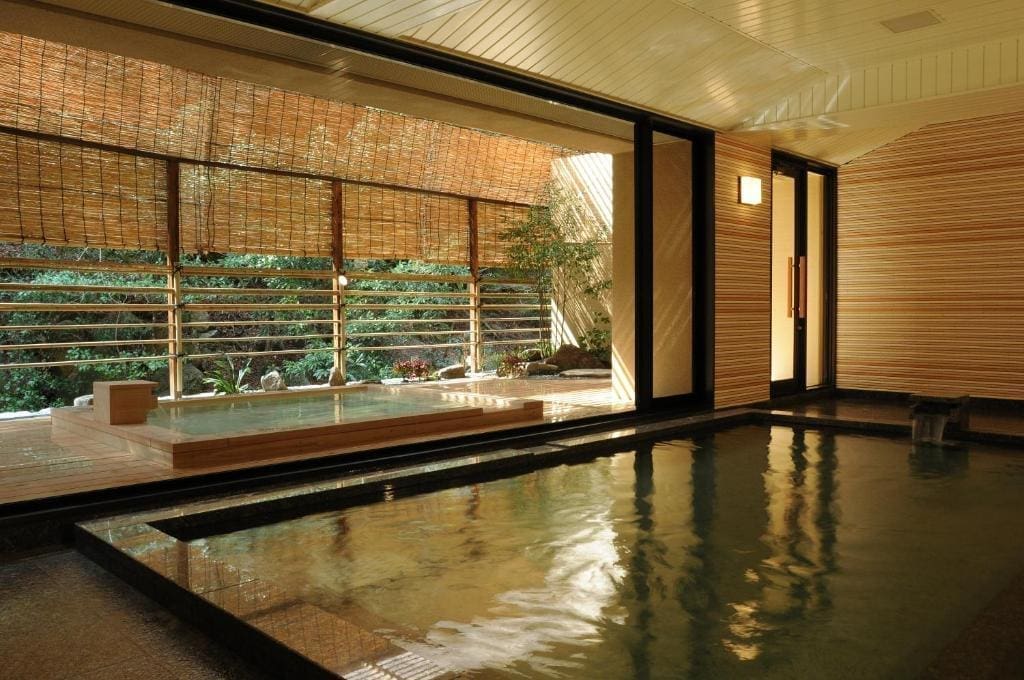
Service is formal but kind. Most of the staff speak a little English, and they’re used to helping foreign travelers. You’ll be greeted by name. Your futon will be laid out while you’re having dinner. If you ask to leave your bags before check-in, they’ll probably be waiting in your room by the time you arrive.
This isn’t the kind of place where you get sleek design or luxury amenities. But if what you’re looking for is the full, traditional ryokan experience—tatami rooms, onsen baths, seasonal food, and calm surroundings—Iwaso is hard to beat.
Kurayado Iroha (Luxury)
- Best for: Travelers who prefer modern design, real beds, and a seamless ryokan experience with comfort and privacy.
- Price range for two adults: ¥60,000-¥350,000
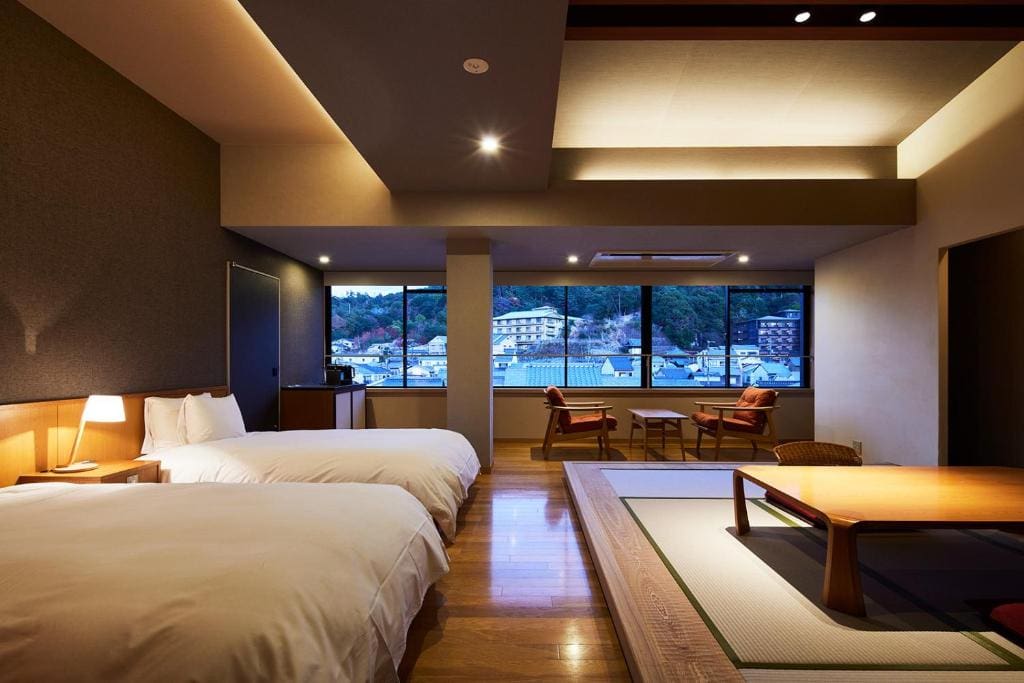
Kurayado Iroha sits just five minutes from the ferry terminal, on the main street that runs through town. From the outside, it doesn’t look like much. But inside, it’s one of the most refined ryokan on the island. Everything feels deliberate, from the soft lighting and quiet tones in the lobby to the layout of the rooms and the design of the rooftop baths. It’s a modern take on the ryokan experience, and it’s done very well.
The rooms mix Western comfort with traditional Japanese style. You’ll find real beds, not futons, but also tatami mats, low tables, and a tea set waiting when you arrive. Some rooms face the sea, others look toward the mountains. All are minimalist in design, with clean lines, warm wood, and soft fabrics. Every room has a private bathroom, and the larger suites come with extra space and seating areas.
Dinner is served in the dining room, not in your room, and the atmosphere is quiet and elegant. The kaiseki meal changes with the seasons and typically includes a balance of seafood, vegetables, and lighter dishes with careful presentation. It’s not the most complex kaiseki you’ll find in Japan, but it’s thoughtful and well-executed. Breakfast can be either Western or Japanese, depending on what you request when checking in.
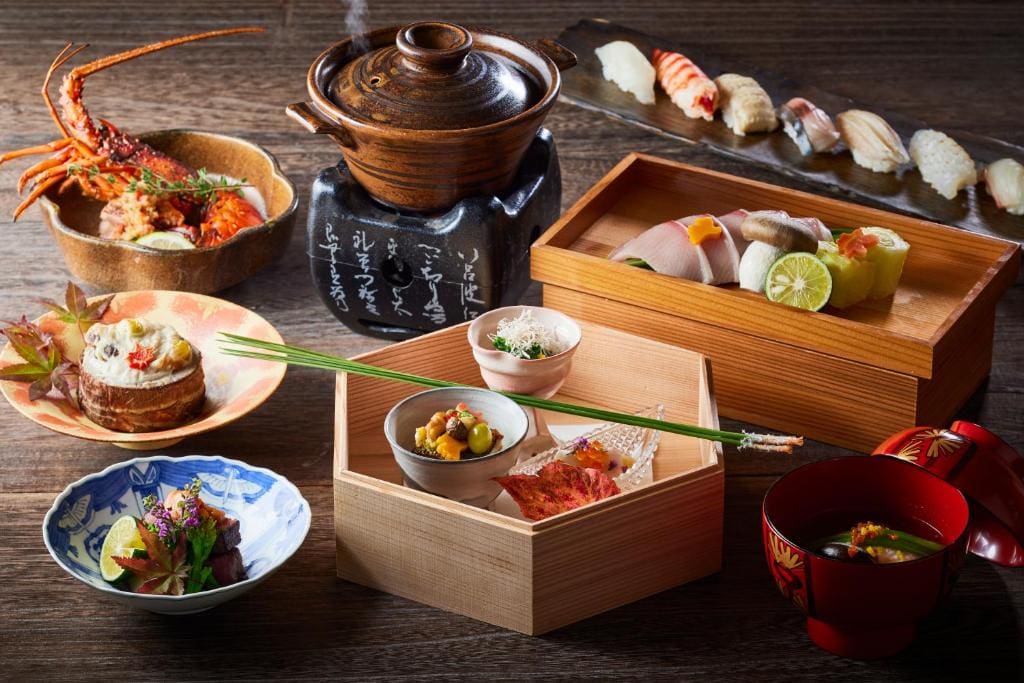
One of the highlights here is the rooftop bath. It’s not large, but it’s beautifully designed, and from the open-air tub, you can see out across the Seto Inland Sea. On clear days or in the right room, you can even catch a view of the torii gate. The baths are divided by gender and rotate depending on time of day. They’re not fed by a hot spring, but the setting is calm and private.
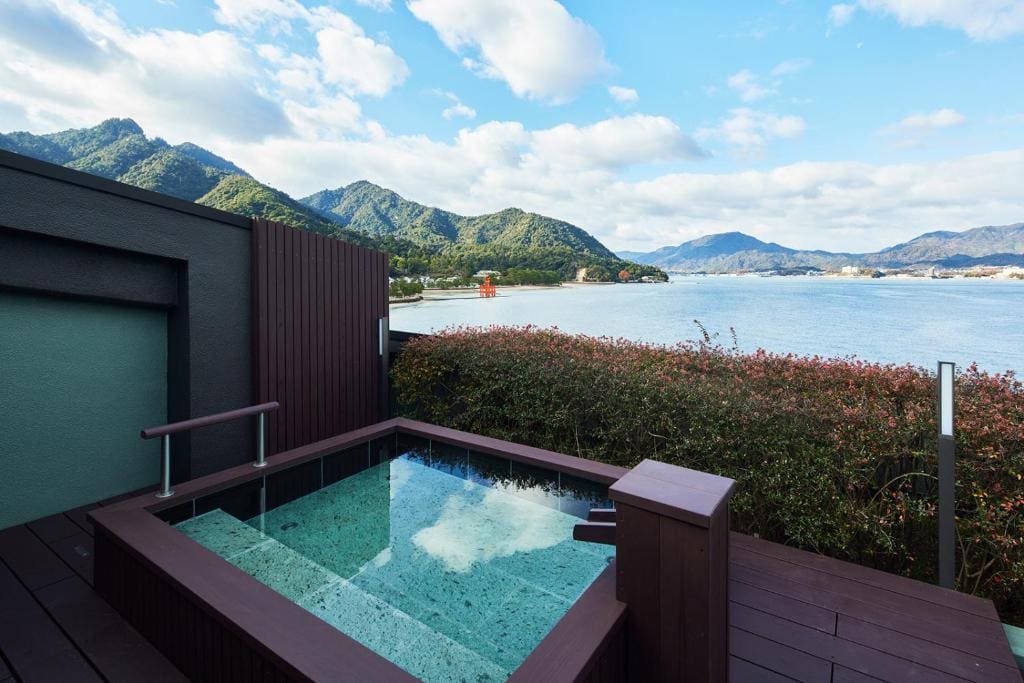
Staff are discreet and professional. They speak English well, and service is efficient without being overly formal. Check-in is quick, and they’ll help with anything you need without hovering.
Kurayado Iroha is not a traditional ryokan in the old-fashioned sense. There’s no in-room dining, no vintage wooden interiors. But if you’re looking for a place that’s calm, tasteful, and easy to access—one that delivers a quiet kind of luxury—it’s a strong choice.
The Bottom Line
If you’re staying just one night, make it count. Yamaichi Bekkan and Ryoso Kawaguchi are excellent value for food lovers. Jukeiso is worth it for the view alone. For full comfort and high-end service, Iwaso and Iroha are both strong picks—but very different in style.

